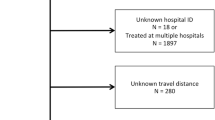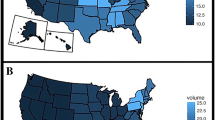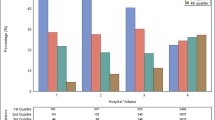Abstract
Background
Regionalization of sarcoma care may improve outcomes. Concerns exist regarding the burdens of travel and its effects on care. We evaluate the presence of a “distance bias”.
Methods
Retrospective cohort study of patients with extremity soft tissue sarcoma (stage I-III) within the NCDB. Travel distance (TD) and hospital volume (VOL) were categorized into quartiles. Alternating statistical models were used for analysis.
Results
1,035 hospitals contributed 11,979 cases. Median and maximum VOL were 5 and 45 cases/year. VOL quartiles were “low-volume” (LV) (892 hospitals, < 3 cases/yr.), “intermediate low-volume” (ILV) (89, 3–5 cases/yr.), “intermediate high-volume” (IHV) (39, 6–12 cases/yr.), and “high-volume” (HV) (15, > 12 cases/yr.). TD quartiles: “short-travel” (ST) (< 8 mi), “intermediate-short travel” (IST) (8–17), “intermediate long-travel” (ILT) (18–49), and “long-travel” (LT) (> 50). VOL but not TD is associated with improved survival [HR 0.65 (CI 0.52–0.83)] and rate of R0 resection [1.87 (CI 1.4–2.5)] but has no effect on amputation rates. Matched analyses demonstrate similar results.
Conclusions
Hospital volume but not distance traveled to treatment facility is associated with improved survival and R0 resections for extremity soft tissue sarcomas. Despite the inconveniences of travel, patients may benefit from treatment at high volume centers.
Graphical abstract




Similar content being viewed by others
References
National Cancer Institute (2019) Surveillance, Epidemiology, and End Results Program. SEER Stat Fact Sheets: soft tissue including heart cancer. National Cancer Institute
Brennan MF, Antonescu CR, Moraco N et al (2014) Lessons learned from the study of 10,000 patients with soft tissue sarcoma. Ann Surg 260:416
Trovik C, Bauer HCF, Styring E et al (2017) The scandinavian sarcoma group central register: 6,000 patients after 25 years of monitoring of referral and treatment of extremity and trunk wall soft-tissue sarcoma. Acta Orthop 88:341–347
Kalaiselvan R, Malik AK, Rao R et al (2019) Impact of centralization of services on outcomes in a rare tumour: retroperitoneal sarcomas. Eur J Surg Oncol 45:249–253
NICE (2006) Improving outcomes for people with sarcoma. UK, National Collaborating Centre for Cancer
Dangoor A, Seddon B, Gerrand C et al (2016) UK guidelines for the management of soft tissue sarcomas. Clin Sarcoma Res 6:20
Kasper B, Lecointe-Artzner E, Wait S et al (2018) Working to improve the management of sarcoma patients across Europe: a policy checklist. BMC Cancer 18:424
Birkmeyer JD, Siewers AE, Finlayson EVA et al (2002) Hospital volume and surgical mortality in the United States. N Engl J Med 346:1128–1137
Macedo FIB, Jayanthi P, Mowzoon M et al (2017) The impact of surgeon volume on outcomes after pancreaticoduodenectomy: a meta-analysis. J Gastrointest Surg 21:1723–1731
Fong Y, Gonen M, Rubin D et al (2005) Long-term survival is superior after resection for cancer in high-volume centers. Ann Surg 242:540
Bagaria SP, Chang YH, Gray RJ et al (2018) Improving long-term outcomes for patients with extra-abdominal soft tissue sarcoma regionalization to high-volume centers, improved compliance with guidelines or both? Sarcoma 2018:8141056
White MG, Applewhite MK, Kaplan EL et al (2017) A tale of two cancers: traveling to treat pancreatic and thyroid cancer. J Am Coll Surg 225(125–136):e126
Wasif N, Chang YH, Pockaj BA et al (2016) Association of distance traveled for surgery with short- and long-term cancer outcomes. Ann Surg Oncol 23:3444–3452
Lamont EB, Hayreh D, Pickett KE et al (2003) Is patient travel distance associated with survival on phase ii clinical trials in oncology? JNCI: Journal of the National Cancer Institute 95:1370–1375
Moten AS, von Mehren M, Reddy S et al (2020) Treatment patterns and distance to treatment facility for soft tissue sarcoma of the extremity. J Surg Res 256:492–501
Lidsky ME, Sun Z, Nussbaum DP et al (2017) Going the extra mile: improved survival for pancreatic cancer patients traveling to high-volume centers. Ann Surg 266:333–338
Beal EW, Mehta R, Hyer JM et al (2019) Association between travel distance, hospital volume, and outcomes following resection of cholangiocarcinoma. J Gastrointest Surg 23(5):944–952
Xia L, Taylor BL, Mamtani R et al (2018) Associations between travel distance, hospital volume, and outcomes following radical cystectomy in patients with muscle-invasive bladder cancer. Urology 114:87–94
Cancer Co National Cancer Database—Tools, Reports, and Resources, 2018.
STATA pctile—Create variable containing percentiles.
Jindal M, Zheng C, Quadri HS et al (2017) Why do long-distance travelers have improved pancreatectomy outcomes? J Am Coll Surg 225:216–225
Blackwell M, Iacus S, King G et al (2009) cem: Coarsened exact matching in Stata. Stand Genomic Sci 9:524–546
Abarca T, Gao Y, Monga V et al (2018) Improved survival for extremity soft tissue sarcoma treated in high-volume facilities. J Surg Oncol 117:1479–1486
Stitzenberg KB, Sigurdson ER, Egleston BL et al (2009) Centralization of cancer surgery: implications for patient access to optimal care. J Clin Oncol 27:4671
Alamanda VK, Delisca GO, Archer KR et al (2013) Incomplete excisions of extremity soft tissue sarcomas are unaffected by insurance status or distance from a sarcoma center. J Surg Oncol 108:477–480
Lyu HG, Haider AH, Landman AB et al (2019) The opportunities and shortcomings of using big data and national databases for sarcoma research. Cancer 125(17):2926–2934
Author information
Authors and Affiliations
Corresponding author
Additional information
Publisher's Note
Springer Nature remains neutral with regard to jurisdictional claims in published maps and institutional affiliations.
Supplementary Information
Below is the link to the electronic supplementary material.
Rights and permissions
About this article
Cite this article
Vidri, R.J., Raut, C.P. & Fitzgerald, T.L. Traveling to Receive Treatment for Extremity Soft Tissue Sarcomas: Is it worth the drive?. World J Surg 45, 2415–2425 (2021). https://doi.org/10.1007/s00268-021-06109-0
Accepted:
Published:
Issue Date:
DOI: https://doi.org/10.1007/s00268-021-06109-0




